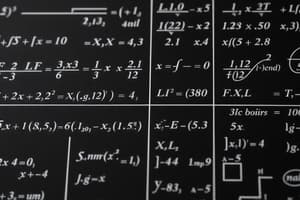Podcast
Questions and Answers
What is the primary focus of differential calculus?
What is the primary focus of differential calculus?
Which application is NOT a typical use of linear algebra in engineering?
Which application is NOT a typical use of linear algebra in engineering?
What type of mathematical equation relates a function to its derivatives?
What type of mathematical equation relates a function to its derivatives?
Which statistical concept is used for estimating population parameters based on sample data?
Which statistical concept is used for estimating population parameters based on sample data?
Signup and view all the answers
What do numerical methods primarily provide for complex problems?
What do numerical methods primarily provide for complex problems?
Signup and view all the answers
Study Notes
Introduction to Engineering Mathematics
- Engineering mathematics provides the tools and techniques used in various engineering disciplines.
- These mathematical tools are vital for problem-solving, analysis, and design in engineering.
- It encompasses a wide range of mathematical concepts, including calculus, linear algebra, differential equations, and probability and statistics.
Calculus
- Calculus is a crucial branch of mathematics used for analyzing continuous change.
- Differential calculus: Focuses on instantaneous rates of change, slopes of curves, and tangents.
- Integral calculus: Deals with accumulating quantities, areas under curves, and volumes.
-
Applications in engineering: Used to model dynamic systems, optimize designs, and analyze physical phenomena.
- Examples include calculating velocity and acceleration in physics, and determining the maximum load capacity of a beam.
Linear Algebra
- Linear algebra provides tools for working with vectors, matrices, and systems of linear equations.
- Key concepts: Vectors, matrices, determinants, eigenvalues, and eigenvectors.
-
Applications in engineering: Used for analyzing systems of equations, representing data, and performing transformations.
- Example applications include circuit analysis, structural analysis in civil engineering, and image processing.
Differential Equations
- Differential equations are mathematical equations that relate a function to its derivatives.
- Types: Ordinary differential equations (ODEs) and partial differential equations (PDEs).
-
Applications in engineering: Used to model various physical phenomena, such as the motion of objects, heat transfer rates, and fluid flow.
- Examples include modeling population growth, electrical circuits, and vibrations.
Probability and Statistics
- Probability and statistics provide frameworks for analyzing uncertainty and variability in data.
- Concepts: Probability distributions (normal, binomial, etc.), statistical inference (hypothesis testing, confidence intervals).
-
Applications in engineering: Used to analyze experimental data, model random phenomena, and make predictions in the face of uncertainty.
- Examples include quality control, risk assessment, and reliability analysis.
Numerical Methods
- Numerical methods provide approximate solutions to problems that are difficult or impossible to solve analytically.
- Techniques: Interpolation, numerical integration, numerical differentiation, root finding algorithms, and solution of systems of equations.
-
Applications in engineering: Used to solve complex engineering problems where analytical solutions are not readily available.
- Examples include finding the roots of polynomial equations, evaluating definite integrals, and approximating solutions to differential equations.
Vector Analysis
- Vector analysis involves working with vectors in three dimensions.
- Concepts: Vector operations, scalar field, vector field, gradient, divergence, and curl.
-
Applications in engineering: Modeling physical phenomena in three dimensions, such as fluid flow, electromagnetism, and heat transfer.
- Examples include calculating forces and moments, determining electric and magnetic fields, or analyzing fluid flow.
Complex Numbers
- Complex numbers are a fundamental concept in engineering mathematics.
- Definition: Numbers of the form a + bi, where a and b are real numbers, and i is the imaginary unit ( i² = -1).
- Applications in engineering: Essential in AC circuits analysis, solving differential equations, and in various signal processing applications.
Fourier Analysis
- Fourier analysis decomposes complex functions into simpler trigonometric functions.
- Concepts: Fourier series, Fourier transforms, and applications in signal processing.
- Applications in engineering: Used extensively in signal processing, image processing, circuit analysis, and vibration analysis.
Studying That Suits You
Use AI to generate personalized quizzes and flashcards to suit your learning preferences.
Description
Explore the fundamental concepts of engineering mathematics, focusing on calculus and linear algebra. This quiz covers essential mathematical tools used in engineering disciplines for problem-solving and design. Topics include differential and integral calculus along with applications in engineering scenarios.




